How have biking conditions been in Latine communities this winter?
8:41 PM CST on January 24, 2022
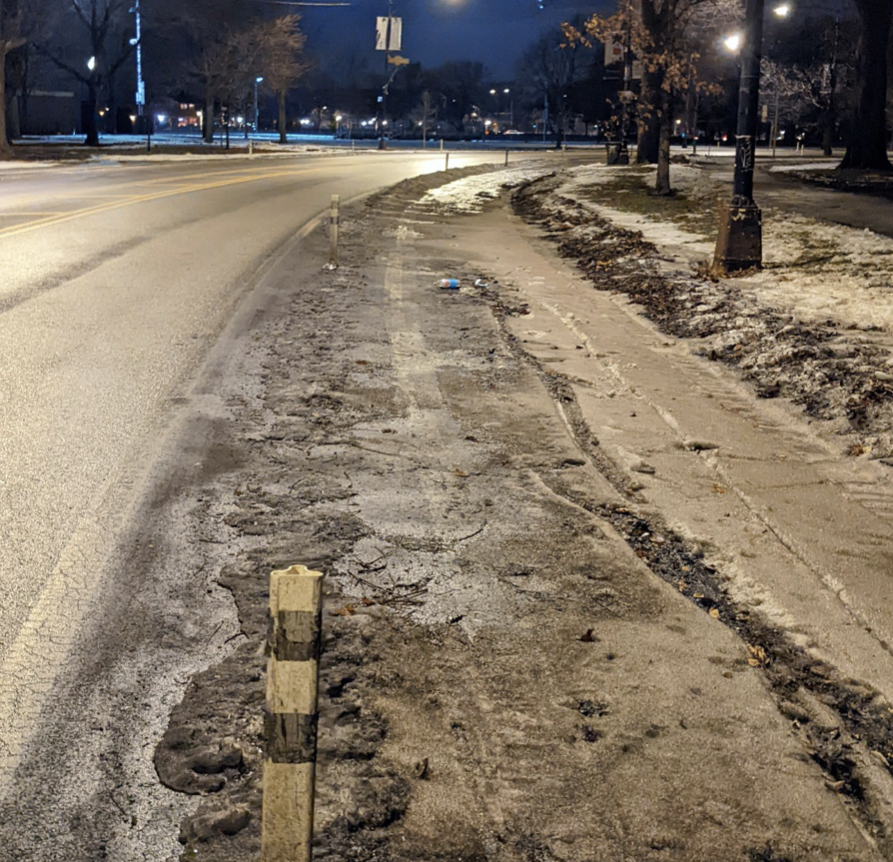
A protected bike lane on California Boulevard near Douglass Park. Photo: Ruth Rosas
Para leer este artículo en español, haga clic aquí.
Often when you tell people you bike through the Chicago winter, they view you with awe and amazement, or else they look at you like you've lost your mind.
Cycling in the winter can feel treacherous. The discomfort of sharing roads is amplified, not just because of freezing temperatures and roadways slick with ice and snow. As winter progresses, the pavement gets worse. Freeze and thaw cycles are destructive, and potholes only seem to get bigger.
After snow falls, sidewalks and streets have to be cleared to make them safer for walking, biking, and driving. But rock salt, which is often used to melt snow and prevent ice, is detrimental to the environment. At high concentrations, rock salt can be toxic to aquatic wildlife, degrade water quality, and even affect drinking water. And ever since Chicago mayor Michael Bilandic lost reelection after the great blizzard of 1979, city officials have been fairly preoccupied with salting the roads if there's even the possibility of a big snow storm.
Despite these downsides, I have found riding in the winter to be fun and pleasant (most of the time.) I would rather ride my bike, getting warmer as I ride, than wait for a train or bus for 30 minutes in the cold. And driving during the Chicago winter seems like a difficult endeavor, since you have to shovel out your car, wait for the engine to warm up, and deal with parking and "dibs" hassles.
In the winter, I often bike to places that are nearby, such as a bus or train stop. That's because it's often easier to access these destinations on wheels than by foot, because roadways are often plowed promptly, whereas it can take days for sidewalks to be cleared. Sometimes property owners don't bother to shovel their sidewalks at all, and they ice over for weeks a time, forcing people to cross the street or walk in the roadway to avoid a slip-and-fall.
Chicago technically requires property owners to clear snow from their sidewalks, but enforcement of this law is spotty. Unfortunately the sidewalks in front of vacant lots or construction projects, as well as on bridges and near viaducts (the Chicago Department of Transportation is responsible for maintaining those) often doesn’t get cleared at all. Although there have been petitions for municipal sidewalk snow clearance by advocacy groups like Better Streets Chicago, this has not happened yet, so we continue to rely on property owners to do the right thing.
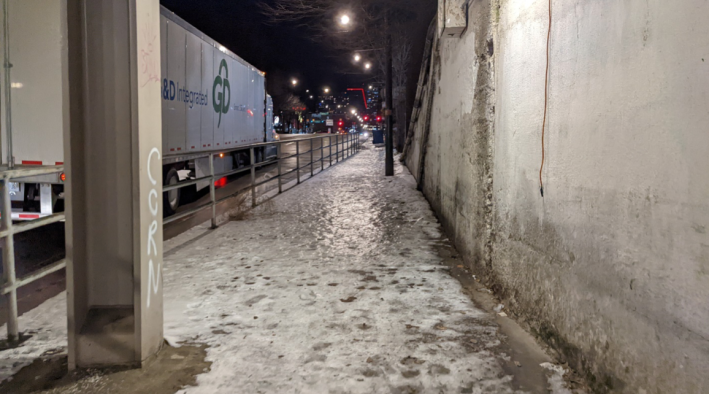
Once you learn how to dress for cold-weather cycling (layers!), two of the keys to successfully biking through the Chicago winter are knowing which streets will likely be clear, and avoiding newly-formed potholes.
Since I commute by bike on most days, I decided to document the roadway conditions in various predominantly-Latine neighborhoods throughout the winter months. A few snowfalls have occurred this winter, and I visited communities on the Southwest and Northwest sides afterwards to see how quickly local main streets were cleared, and check on the status of the bike lanes. Next time it snows, I plan to ride down further south and explore how well Back of the Yards and East Side bikeways are maintained.
As expected, after snowfalls and/or freezing temperatures, the roadways were harder to navigate. A few times this year we have been unlucky in that bitterly cold temperatures set in right after a snowfall. When that happens, if roads and sidewalks are not cleared quickly enough, the snow quickly ices over.
I found that in most parts of the city, if the bike lane is paint-only, it tends to be cleared with the rest of the roadway. However, I saw a few streets where the snow was pushed into the parking lane, and spilled over into the unprotected bike lane.
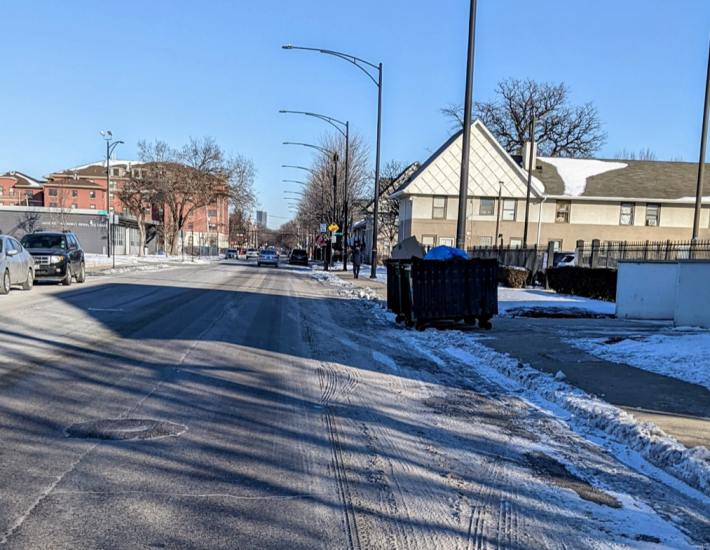
While biking from Little Village to North Lawndale, I rode in the protected bike lanes on Sacramento Drive that merges into Marshall Boulevard and California Boulevard in Little Village. The protected lanes are not shoveled right after snowfalls. (See the photo at the top of this post.) Parts of it are cleared after a few days, but major segments are still completely unusable. That meant I had to ride in the mixed-traffic lane. North of Ogden Avenue in North Lawndale, I found the protected bike lanes to be clearer. However, patches of snow and ice were still present.
In Brighton Park, there are no bikeways at all, let alone protected bike lanes. I found the streets to be mostly clear and salted, although there were unexpected potholes and debris I had to slowly bike around.
In McKinley Park, the Pershing Road buffered bike lanes, the only bikeways in the neighborhood, were well-maintained, clear of snow, ice, and debris. I found most of the other streets I rode on to be clear as well.
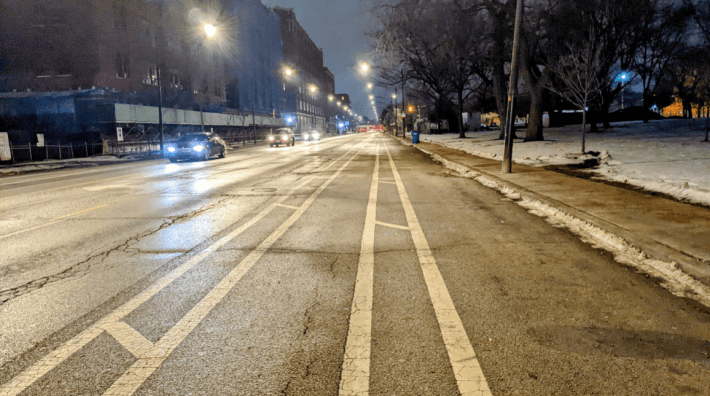
Last year CDOT began building a new network of bike lanes in Belmont Cragin, with input from local residents on where the bikeways should go. Many of these roads have been recently repaved, and when I visited after a snowfall, I found that the most of the bike routes, which lack physical protection, were clear.
In Logan Square, the formerly-controversial Milwaukee Avenue bike lanes, which are partially protected with plastic curbs and flexible posts, were mostly clear, but still hard to navigate in certain areas. Northwest of Western Avenue, there were cracks that run along the edges, and there was a lot of debris in the lanes. There are also areas in the bike lane where snow or ice has not been cleared. The smaller residential streets I rode on in Logan Square were generally clear, but the potholes and cracks make them scary to navigate.

Humboldt Park was easier to navigate. The streets were generally cleared. The non-protected bike lanes along California Avenue, Kedzie Avenue and Augusta Boulevard did not have much snow, ice, or debris.
Grand Avenue, a major northwest arterial street that serves various neighborhoods like Humboldt Park, Belmont Cragin, and Austin, is partially under construction. There were steel road plates that are slippery when it is cold and wet. Grand in Belmont Cragin is slated to get bike lanes later this year.
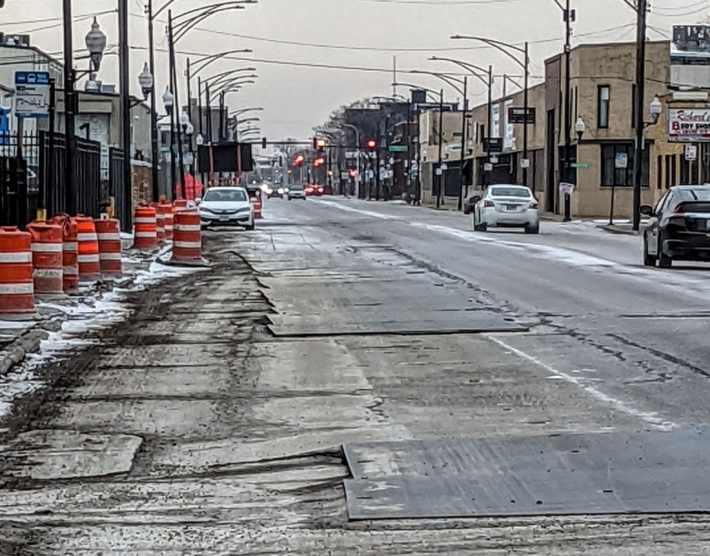
My motivation to keep an eye on bike lanes and roadways is to ensure that maintenance becomes part of every single roadway construction conversation. CDOT should be as diligent in plowing all painted and protected bike lanes as they are about clearing streets for drivers. If they are not cleared, these bikeways that are supposed to help us ride safety instead wind up constraining our mobility. And even in warmer months, when more people feel motivated to bike, potholes and cracks are a nuisance and can lead to unsafe, or at least unenjoyable, bike rides.
Stay in touch
Sign up for our free newsletter
More from Streetsblog Chicago
Which Metra corridor would become more bike-friendly and greener under a new plan? Ravenswood!
Thanks to plans to convert little-used parking spaces, the avenue is slated to get a new bike lane, and the Winnslie Parkway path and garden will be extended south.
They can drive 25: At committee meeting residents, panelist support lowering Chicago’s default speed limit
While there's no ordinance yet, the next steps are to draft one, take a committee vote and, if it passes, put it before the full City Council.
One agency to rule them all: Advocates are cautiously optimistic about proposed bill to combine the 4 Chicago area transit bureaus
The Active Transportation Alliance, Commuters Take Action, and Equiticity weigh in on the proposed legislation.



